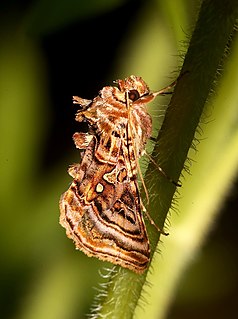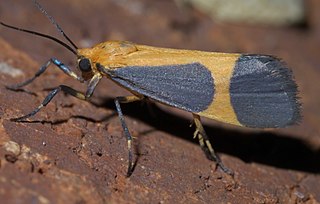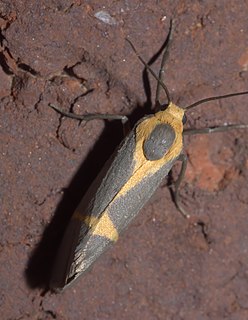
Citheronia sepulcralis, the pine-devil moth, is a Nearctic member of the family Saturniidae and of the subfamily Ceratocampinae. The species are blackish brown. The species was first described by Augustus Radcliffe Grote and Coleman Townsend Robinson in 1865.

Cisthene is a genus of lichen moths in the family Erebidae. The genus was erected by Francis Walker in 1854.

Acronicta funeralis, the funerary dagger moth or paddle caterpillar, is a moth of the family Noctuidae. The species was first described by Augustus Radcliffe Grote and Coleman Townsend Robinson in 1866. It has a scattered distribution. It is found in North America from Manitoba to Nova Scotia, south to Maryland. It is also found in Georgia, Mississippi, Texas, and along the west-coast from California to British Columbia.

Autographa mappa, the wavy chestnut Y, is a moth of the family Noctuidae. The species was first described by Augustus Radcliffe Grote and Coleman Townsend Robinson in 1868. It is found in North America from Newfoundland west across the wooded portions of Canada to Vancouver Island, south in the east to Maine, New Hampshire and Wisconsin, and in the western mountains south to Colorado and Oregon.

Cisthene plumbea, the lead-colored lichen moth, is a moth of the family Erebidae. The species was first described by Richard Harper Stretch in 1885. It is found in eastern North America, from southern New Jersey south to northern Florida, west to Wisconsin and Texas.

Acontia cretata, the chalky bird dropping moth, is a moth of the family Noctuidae. The species was first described by Augustus Radcliffe Grote and Coleman Townsend Robinson in 1870. It is found from the US states of California to Texas and Oklahoma, north to Colorado and Utah.

Deltote musta, the small mossy lithacodia moth, is a moth of the family Noctuidae. The species was first described by Augustus Radcliffe Grote and Coleman Townsend Robinson in 1868. It is found in the US from New Hampshire to Florida, west to Arizona and north to Wisconsin.
Crambidia cephalica, the yellow-headed lichen moth, is a moth of the family Erebidae. It was described by Augustus Radcliffe Grote and Coleman Townsend Robinson in 1870. It is found in the central and southern part of the United States, from eastern Nevada, Utah and Arizona to southern Ohio, Tennessee, North Carolina and northern Georgia. The habitat consists of steppes and open forests.
Cisthene martini, or Martin's lichen moth, is a moth of the family Erebidae first described by Carroll B. Knowlton in 1967. It is found in the US states of Arizona, New Mexico and Texas.
Cisthene deserta is a moth of the family Erebidae. It was described by Felder in 1868. It is found in North America, where it has been recorded from Utah and California.
Cisthene dorsimacula is a moth of the family Erebidae. It was described by Harrison Gray Dyar Jr. in 1904. It is found in southern California, United States.
Cisthene juanita is a moth of the family Erebidae. It was described by William Barnes and Foster Hendrickson Benjamin in 1925 and is found in the United States in southern Arizona.

Cisthene kentuckiensis, the Kentucky lichen moth, is a moth of the family Erebidae. It was described by Harrison Gray Dyar Jr. in 1904. It is found in the United States from New Jersey south to northern Florida, and west to Missouri, Oklahoma, and Texas.

Cisthene packardii, or Packard's lichen moth, is a moth of the family Erebidae. It was described by Augustus Radcliffe Grote in 1863. It is found in the US from the states of New York to Florida and from Missouri to Texas. The habitat consists of barrens and dry oak woodlands in the northern part of the range and a variety of woodlands and scrubs in the south.
Cisthene perrosea is a moth of the family Erebidae. It was described by Harrison Gray Dyar Jr. in 1904. It is found in the US from California to Utah, New Mexico and western Texas.

Cisthene picta, the pictured lichen moth, is a moth of the family Erebidae. It was described by William Barnes and James Halliday McDunnough in 1918. It is found in the United States from Texas to Arizona. The habitat consists of deserts.

Cisthene tenuifascia, the thin-banded lichen moth or three-banded lichen moth, is a moth of the family Erebidae. It was described by Leon F. Harvey in 1875. It is found in Mexico and from Arizona to Florida, North Carolina and Oklahoma. Strays can be found further north.

Hahncappsia marculenta is a moth in the family Crambidae. It was described by Augustus Radcliffe Grote and Coleman Townsend Robinson in 1867. It is found in North America, where it is widespread east of the Rocky Mountains.

Diacme adipaloides, the darker diacme moth, is a moth in the family Crambidae. It was described by Augustus Radcliffe Grote and Coleman Townsend Robinson in 1867. It is found in North America, where it has been recorded from Alabama, Arkansas, Florida, Indiana, Maine, Maryland, Massachusetts, Michigan, Minnesota, New Brunswick, New Hampshire, New Jersey, New York, North Carolina, Nova Scotia, Ohio, Oklahoma, Ontario, Quebec, South Carolina, Tennessee, Texas, Virginia, West Virginia and Wisconsin.













